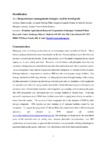Please use this identifier to cite or link to this item:
http://www.alice.cnptia.embrapa.br/alice/handle/doc/1017025| Title: | Integrated pest management strategies used in stored grain. |
| Authors: | LORINI, I.  FERREIRA FILHO, A.   LUNARDI, L.   MARCHI, F. de   ANTUNES, J. M.   BONATTO, L. T. D.   |
| Affiliation: | IRINEU LORINI, CNPSO; ARMANDO FERREIRA FILHO; LISANDRA LUNARDI, CNPT; FATIMA MARIA DE MARCHI, CNPT; JOSEANI MESQUITA ANTUNES, CNPT; LICIANE TOAZZA DUDA BONATTO. |
| Date Issued: | 2012 |
| Citation: | In: SIMPÓSIO SOBRE INOVAÇÃO E CRIATIVIDADE CIENTÍFICA NA EMBRAPA, 1., 2008; SIMPÓSIO SOBRE INOVAÇÃO E CRIATIVIDADE CIENTÍFICA NA EMBRAPA, 2., 2010, Brasília, DF. Trabalhos apresentados e documentos... Brasília, DF: Embrapa, 2012. 1 DVD. |
| Description: | Managing pests of stored grain has become an increasingly serious problem in Brazil. This is because grain production has more than doubled in the last 10 years and insect pests have become resistant to protectant insecticides. In the same period, use of phosphine fumigation has increased rapidly and is now widely practised. However, control failures with phosphine have become common as fumigations are undertaken in unsealed silos and in situations where sanitation is poor. As a consequence, many parcels of grain are repeatedly fumigated. In response to this situation, Embrapa initiated a programme to introduce IPM into the central grain storage facilities. Our strategy included the following elements: (a) changing behaviour through training of the storage facilities personnel; (b) improving knowledge of stored grain unit; (c) cleanliness of the equipment and premises and, after that, spray residual insecticide; (d) identification of grain-stored pests; (e) resistance tests; (f) insecticide treatment and fumigation; (g) sampling and monitoring the grain. The IPM programme was introduced into two storage facilities in Paraná State. Following successful implementation of IPM, these facilities were able to supply insect-free grain and had a bonus from the market. The success of these companies led to the adoption of IPM by other storage companies. IPM systems are now running in 13 separate facilities owned by nine companies. To support the programme, Embrapa Wheat has trained more than 1,000 stored grain operators and released an IPM manual and website www.cnpt.embrapa.br/pesquisa/entomologia/mip. The challenges to be pursue for the next fifteen years of the research team are sealing silos, measure phosphine concentrations, pure PH3 applications, new protectants as spinosad (the bacterial derivate pesticide), offering technologies to guarantee high quality grains with insect free and residues free in the international market. |
| Keywords: | Grãos |
| Type of Material: | Resumo em anais e proceedings |
| Access: | openAccess |
| Appears in Collections: | Resumo em anais de congresso (CNPSO)  |
Files in This Item:
| File | Description | Size | Format | |
|---|---|---|---|---|
| lorini.pdf | 6.42 kB | Adobe PDF |  View/Open |









